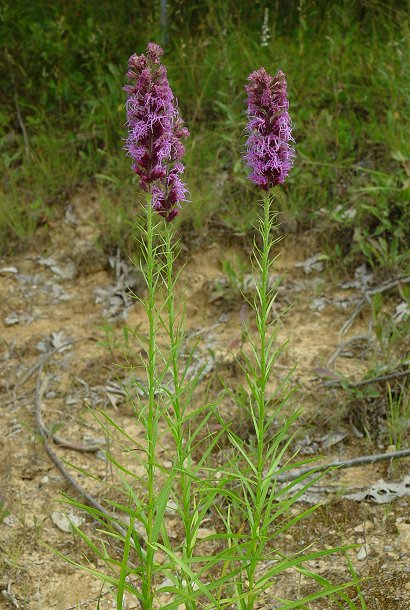Liatris pycnostachya Michx.
Gayfeather

Native
CC = 6
CW = 0
MOC = 67
© DETenaglia
Liatris pycnostachya Michx.Gayfeather | |
 |
Native CC = 6 CW = 0 MOC = 67 |
© DETenaglia |
|
Family - Asteraceae/Eupatorieae Habit - Perennial forb from a globose corm. Stems - Erect, to 1.5 m, moderately to densely pubescent with short, curled hairs, often nearly glabrous toward the base.
Leaves - Alternate, simple, entire. Basal and adjacent lower stem leaves mostly short-petiolate, the blades 8-40 cm long, 3-13 mm wide, linear or narrowly oblanceolate, the surfaces glabrous to densely short-hairy, green, with 3 or 5 main veins, grading to the shorter stem leaves, these mostly sessile, 1.5-15.0 cm long, linear or very narrowly oblanceolate to very narrowly lanceolate. Upper leaves typically numerous and crowded along the axis.
Inflorescences - Elongate spicate racemes to 40 cm, the heads densely spaced (the axis mostly not visible between heads), sessile or with stalks to 1 mm long, these with only 1 basal bract.
Heads - Heads discoid, with 4-9 florets, the terminal head not or only slightly larger than the others. Involucre 7-11 mm long, narrowly cup-shaped to nearly cylindrical, with 4 or 5 unequal, overlapping series of bracts, the outer series appearing progressively shorter. Involucral bracts broadly lanceolate to oblong-lanceolate, tapered to a long, sharply pointed, spreading or recurved tip, mostly with thin, pale to transparent margins, the margins or entire bract sometimes strongly purplish-tinged, minutely irregular or more commonly with irregular, hairlike processes, the main body appearing flat below the tip.
Flowers - Ray florets absent. Disk corollas 7-10 mm long, pink, glabrous, the 5 lobes acute, erect to spreading, 2 mm long. Pappus bristles barbed but not plumose. Stamens 5, adnate about 1/3 to 1/2 way up the corolla tube. Anthers connate around style, 3 mm long, brownish-purple. Style exserted, bifurcate. Stigma deep pink.
Fruits - Achenes 3.5-5.0 mm long, densely pubescent, 3-sided.
Flowering - July - October. Habitat - Glades, prairies, bluffs, savannas, upland forest openings, ditch banks, fencerows, pastures, railroads, and roadsides. Origin - Native to the U.S. Lookalikes - L. mucronata. Other info. - This species is commonly seen in prairie habitats and along roadsides in the Ozarks. It occurs throughout most of Missouri, and also within a band extending from Minnesota southward to the Gulf Coast. The numerous linear leaves and densely flowered spikes are good characteristics for identifying the species. The pappus bristles are simply barbed, in contrast to the plumose pappus bristles found in L. mucronata. Species distinctions within the Liatris genus can be difficult. Photographs taken at Taum Sauk Mountain, MO., 7-28-03 (DETenaglia); also at Weldon Spring Conservation Area, St. Charles County, MO, 7-27-2009, Shaw Nature Reserve, Franklin County, MO, 7-20-2023, and Schuette Prairie, Polk County, MO, 8-6-2024 (SRTurner). |